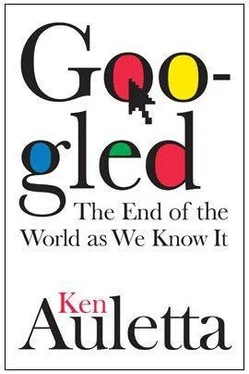IN THIS BACK-TO-THE-FUTURE moment, online companies ape broadcasters by proclaiming that their services are “free” because advertisers pay for them. This is the answer touted by Wired editor Chris Anderson in his latest book, Free: The Future of a Radical Price. He argues that making information free allows digital content creators to use the Internet as a promotional platform to create alternate money streams, including concerts, selling goods and lectures and premium services. In the digital world, he writes, “Free becomes not just an option but an inevitability Bits want to be free.” In his spirited book What Would Google Do? Jeff Jarvis argues that online news aggregaters like Google are the equivalent of newsstands that help papers boost online circulation and serve as promotional platforms for the newspapers. By increasing their online traffic, Jarvis posits, aggregaters allow papers to charge a steeper price for their online ads. “I believe papers should beg to be aggregated so more readers will discover their content,” he writes. He concludes, “Free is impossible to compete against. The most efficient marketplace is a free marketplace.”
There is no question that links increase the number of newspaper readers. Marissa Mayer said that Google search and Google News generate “more than one billion clicks per month” for newspaper sites. But for “free” to work as Jarvis says it will, news aggregaters like Google or Yahoo would have to be gushing money into newspaper coffers. They are not. While Larry Page, Sergey Brin, and Eric Schmidt insist they want to help newspapers, and AdSense does bequeath ad revenues to newspapers, the three men admit AdSense’s receipts are relatively modest, too meager to restore newspapers to health. Jarvis is correct that free “is impossible to compete against,” but I fear that the consequence will be the opposite of the one he intended. For newspapers, if revenues continue to fall short of costs, free may be a death certificate.
Second, advertising is a wobbly crutch. In economic downturns, ad expenditures are usually among the first to be pared. Indeed, in harmony with the worldwide recession, total U.S. ad spending dropped in 2008, and in 2009 Jack Myers, a respected marketing consultant, projects that total advertising will plunge 12.1 percent. Newspaper ad revenues, according to ZenithOptimedia, will fall from $44 billion in 2008 to $37.4 billion in 2009, or 8 percent; Jack Myers predicted the falloff would be almost three times greater (22 percent). And just as the Internet has disrupted traditional ad sales, it may well disrupt the effectiveness of advertising itself. Consumers now have the tools to easily comparison shop online, to compare prices and performance reviews. The emotional power of a commercial is weakened by the informational power of the Web. Even Wired editor Chris Anderson, who once more forcefully advocated that free was the perfect model, has changed his position. Blaming the deep recession, Anderson appended a “Coda” chapter at the end of his book in which he amends what he wrote earlier. He writes that he now believes “Free is not enough. It also has to be matched with Paid.”
Third, to rely solely on advertising is to risk becoming dependent on a revenue source whose interests may diverge from those of good journalism. The wall between advertising and news was erected to ensure that news was not at the service of commercial interests. This wall is easier to maintain when newspapers can buttress their ad revenues with subscriptions and newsstand sales. In a February 2009 Time cover story titled “How to Save Your Newspaper,” former Time editor Walter Isaacson quoted Henry Luce, cofounder of the magazine, as saying that to rely solely on advertising was “economically self-defeating.” Luce, Isaacson wrote, “believed that good journalism required that a publication’s primary duty be to its readers, not to its advertisers.” The warning was given life several weeks later when the management of Time Inc. goaded five of its magazines-Time, Fortune, People, Sports Illustrated, and Entertainment Weekly-to prepare major stories on a new 3-D animated movie from DreamWorks, Monsters vs. Aliens. The publications would each receive advertising from three of DreamWorks’ corporate partners on the movie, McDonald‘s, HP, and Intel. Many other media companies have felt compelled to make similar Faustian bargains, potentially trading credibility for dollars. In April 2009, page one of the Los Angeles Times featured an ad for a new NBC show that was laid out to look at first glance like just another news story
It is no surprise that advertisers will always want the most conducive setting for their ads; they want to sell products and have perfectly good business reasons to be concerned with the environment in which their ads appear. The problem is that this impulse leads them to push for more “friendly” news: a senior network news executive said, “I’ve seen increasing incursions by advertisers into morning show content. Can the evening news be far behind?” Of course, network news has in recent years made itself more of an inviting target for advertisers by allowing the morning shows and evening newscasts to become “softer” and more superficial. Likewise, it is as certain as a sunrise that advertisers will want tamer social networks and more predictable YouTube videos to accompany their products. To better target their ads, they also want to extract as much information about their potential customers as they can. But news outlets or Web sites that share users’ private information or allow themselves to be seen as bought and paid for will lose the trust of their customers. An additional revenue source will give them more leverage to resist.
When media companies depend solely on advertising revenues, there is also a real risk to quality. As more people read newspapers online, or watch their favorite TV shows online, or illegally but effortlessly download movies or music, the revenues of traditional content companies will fall. While it is true that too few newspapers do a good job of covering state capitals or city hall, or sustaining investigative reporting or investing resources in international news, those elite papers that do-the New York Times, Wall Street Journal, and Washington Post-are hobbled; that kind of reporting is expensive. Similarly, a television network’s ability to invest in expensive but exemplary programs like Friday Night Lights, 30 Rock, or even the more popular fare-Desperate Housewives, CSI: Miami -will be endangered.
A total reliance on advertising can menace many new media sites as well. Facebook and YouTube and Twitter have an enormous base of users, but they lose money Sites like Facebook and MySpace struggle to devise ad-friendly formats, but have so far stumbled. Robert Pittman, the former president of AOL, thinks he knows why: “Wrestling had bigger audiences than some prime-time shows, yet wrestling never monetized well. Why? Because most advertisers didn’t want to be associated with it. Environment did matter. We had huge audiences on AOL chat rooms. We couldn’t sell it worth a damn. People were communicating. They didn’t want to be interrupted by ads. You start running an ad on Facebook and users will say, ‘I don’t like GAP. Don’t put GAP on my page!’ It will attract some advertising dollars. But I don’t think social networks monetize to the size of the audience they have. The advertiser doesn’t want to be in an environment where they feel they are a big negative.” Social networks might be able to sell more ads if they share more of their users’ private information with advertisers, but when Facebook tried that approach in 2007 with an ad program called Beacon, irate users forced it to install a system that relied on the users’ willingness to participate. Eventually, if these sites cannot devise an ad formula that works, they will once again demonstrate-as AOL chat rooms or Friendster.com did-that advertisers may not always follow the audience.
Читать дальше










